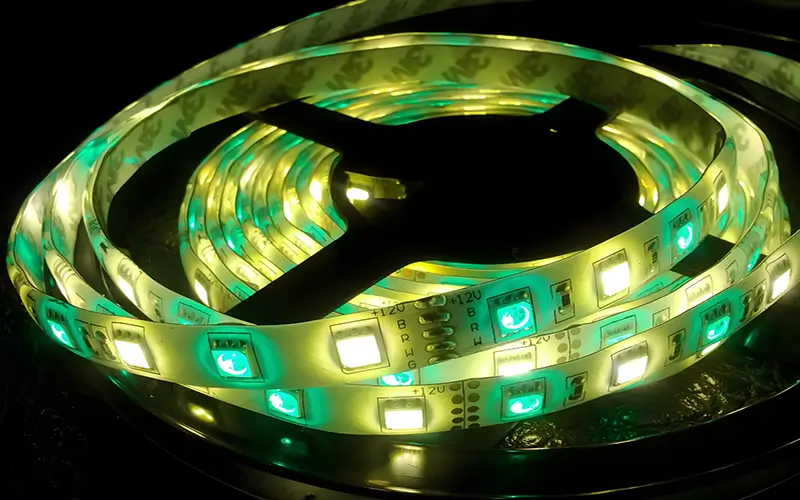
RGB vs. RGBW LED strip lights are a crucial topic for anyone interested in modern lighting solutions. Most people are very interested, so let’s dive into the details, explain the differences, and help you decide which one is best for your needs.
What are RGB LED Strips?
RGB LED strips are a popular choice for decorative lighting and are available in a wide range of colors. RGB stands for Red, Green, and Blue. These strips contain individual LEDs that emit these primary colors. For RGB more information, pls read What is an RGB LED Strip Used For?
By controlling the intensity of each color, a large number of secondary and tertiary colors can be created through light mixing.
What are RGBW LED Strips?
RGBW is based on the RGB concept, adding a separate white LED chip to the red, green, and blue LED chips.
This white is a true white, not dimmed by RGB. So we all know that the additional white LED can achieve a wider color spectrum and can achieve true white light, which is difficult to achieve with standard RGB.
Differences Between RGB vs. RGBW LED Strips
There are actually many differences between RGB vs. RGBW LED light strips. We can analyze them in detail from aspects such as raw materials, usage, color, and cost.

Raw Materials
- RGB: RGB LED strips contain red, green, and blue diodes. Users can mix these three primary colors at different intensities to get a variety of colors they want.
- RGBW: RGBW strips have a separate white diode in addition to red, green, and blue diodes. This allows the strip to emit pure white light in addition to the color mixing capabilities of RGB.
Color Range
- RGB: The basic primary colors of RGB strips are red, green, and blue. Through the mixing of ratios, it can produce a variety of colors, so they rely on mixing primary colors to achieve these colors.
- RGBW: On the basis of RGB, adding white LEDs can achieve more subtle and accurate color performance. By mixing white with RGB LEDs, users can achieve a wider range of colors.
Brightness
- RGB: While RGB strips are bright and available in high power, the lack of dedicated white LEDs may limit their use in situations where high brightness is needed for general lighting.
- RGBW: Adding white LEDs generally makes RGBW strips brighter, with the white LEDs operating independently. It provides more even, crisper lighting for certain tasks.
White Light Quality
- RGB: The “white” produced by RGB light strips is not true white because it is the result of the combination of three color diodes (R, G and B). White may appear slightly off.
- RGBW: The W in RGBW is pure white, so it can provide true white. RGBW light strips can provide cool white and warm white variations, making them more suitable for different lighting environments.
Power Consumption
- RGB: Since RGB strips only contain three diodes (red, green, blue), they usually consume less power than RGBW strips. However, there are also high-power RGB LED strips.
- RGBW: RGBW LED strips consume more power because they have an additional white diode. Also, you need to be aware that if you mainly use the white mode instead of the color-changing mode, the power consumption may be comparable to using a dedicated white strip.
Cost Budget
- RGB: These strips are usually a bit cheaper than RGBW. Generally, if there is no special need, you can directly choose RGB.
- RGBW: RGBW LED strips tend to be more expensive because of the additional white diodes and increased flexibility of lighting options.
Lighting Applications
- RGB: It is ideal for areas where decorative lighting and mood lighting are the main focus. For example, living rooms, KTVs, various activities and entertainment areas, etc.
- RGBW: Best for decorative lighting and functional lighting. RGB can provide the fun of color-changing modes to create atmosphere. And the pure white option makes RGBW light strips ideal for areas that require practical lighting.
Installation
- RGB: Since it only handles three colors, it is easier to install with a simpler controller setup.
- RGBW: It is slightly more complicated to install because it requires a controller that can manage a fourth channel (white diode).
How to Choose RGB vs. RGBW LED Strips?
Choosing between RGB vs. RGBW LED strips, I think, depends mainly on the intended use and effect and the lighting effect required.
Decorative and effect: If you mainly need colored lighting for decorative purposes, then RGB is an excellent choice. But if your lighting requires accurate color reproduction and needs to achieve pure white light, then RGBW strip lights are your best choice. It performs well anywhere there is a natural white light option and color effects.
Cost budget: Consider the budget and cost, which is the most important point. Try to choose high-quality LED strip lights, so that the cost of replacement is reduced.
Summary
Understanding the difference between RGB vs. RGBW LED strips, can help you choose them better. RGB LED strips are more suitable for decorative purposes, providing bright colors and interesting lighting effects. On the other hand, RGBW offers a wider color spectrum, enhanced color accuracy, brightness, and versatility.
We have more high-quality RGB and RGBW strips, as well as the latest COB RGB and RGBW LED strips, please let me know if you have any needs.
